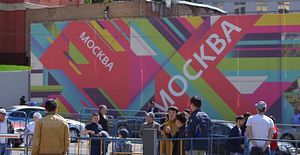There is no dearth of coverage of Russia in the mainstream media these days, whether it concerns the alleged campaign mounted by the Kremlin to influence the outcome of last year’s U.S. presidential election or the country’s ongoing role in the Syrian civil war.
A little known fact about Russia, however, is that since the collapse of the Soviet Union in 1991, it has become one of the main destinations for immigration in the world. According to figures from the United Nations 2015 international migration report, the country is tied with Germany for the second spot in terms of the number of migrants living within its borders, with the United States at the top of the list.
Unlike Germany and Europe, however, the vast majority of people going to Russia aren’t political refugees and asylum seekers fleeing war and persecution, but economic migrants looking for employment opportunities. Most of these migrants come from the former Soviet space, with Central Asia at the forefront of this massive human flow.
Every year, tens of thousands leave the republics of Kyrgyzstan and Tajikistan — the poorest countries in Central Asia — to find seasonal employment in Russia’s main cities. Many stay for years; others never return home, but their remittances form an important share of their country’s economy. The World Bank estimates that, in 2014, money sent back home by migrants was comparable to 36.6 percent of Tajikistan’s GDP, and 30 percent of Kyrgyzstan’s.
“Moscow’s Little Kyrgyzstan,” a 25-minute documentary film shot in the summer of 2016, offers glimpses into the lives of some Kyrgyzstani migrant workers among the millions living in the Russian capital. The “migrant” label hides the diverse reality of people from different walks of life but united in the common struggle for a better future unattainable in their country of origin. The movie touches upon various issues affecting their everyday lives, such as Russia’s corrupt state bureaucracy, harassment from the police, and anti-immigrant sentiment among the general Russian population.
Bermet Borubaeva works as a PR manager at the renowned Fabrika Art House in Moscow, whose premises are used by Russian and foreign artists to create and present their work. She moved to Russia from Kyrgyzstan to pursue graduate studies, but had to find employment to support herself once her brother — also a migrant worker — was arrested for a minor infraction, almost immediately deported and blacklisted for the next five years.
This isn’t uncommon. As Crisis Group reports, “while migrants from Central Asia have visa-free travel to Russia, administrative and residency requirements often leave them working illegally, vulnerable to exploitation or deportation. Small rule infringements can lead to being blacklisted for up to five years.”
Privileged access to the Russian labor market was one of the key factors behind Kyrgyzstan joining the Eurasian Economic Union (EEU) in August 2015, a Kremlin-led bloc that also includes Kazakhstan, Belarus and Armenia. “In theory,” Crisis Group continues, “EEU membership reduces the administrative burden for labor migrants, ending requirements for Kyrgyz[istanis] and Armenians to pass language and history exams and allowing them to spend a month in Russia before registering.”
Progress has been slow, however. Faced with a daunting bureaucracy staffed with corrupt officials, many migrant workers continue to live in a legal grey area with little to no protection. Often, this means having to bribe police officers to avoid being harassed or threatened with deportation; at times, this can end in tragedy, as with the Moscow warehouse fire that killed 17 last summer.
Despite all this, and despite Russia’s economic recession in the past couple of years due to low oil prices and Western sanctions linked to the war in Ukraine, migrant workers from Kyrgyzstan are undeterred. Nurgul Kaimova is from the southern city of Osh. After working a few different temporary jobs, she finally managed to establish herself as a real estate agent, and opened an office in Moscow. In the last years, she has noticed a significant increase in youth migration to Russia from her country.
“No one intends to leave [Russia]. Very many people stay here, give birth, their children go to kindergarten or to school. [If] in the past people would leave their children [in Kyrgyzstan] and come here alone for one or two years to work, now they come with their families and settle down here,” Nurgul says.
Migration isn’t a new phenomenon in the history of humanity; borders are. Many of the problems facing migrant workers coming to Russia from Central Asia are common to those encountered by immigrants and refugees elsewhere in the world: exploitation at the hands of corrupt officials and employers; bureaucratic systems with ever-changing and over-complicated rules that deter regularization rather than encourage it; lack of legal protection.
As the demand for cheap labor in more developed economies is matched by the desire of millions to find employment in the hope of a better future for themselves and their families, migration flows won’t stop. In Russia and elsewhere, however, the situation for migrants looks grim. As Bermet remarks, “this doesn’t happen only in Russia but globally; it is a neoliberal economic trend, whereby a precarious labor force is exploited and all conditions are created [to have] illegal workers. [They] haven’t got labor contracts, so they can be paid very little, or late, or not at all. They haven’t got those labor rights which are guaranteed by law, meaning that on construction sites workers can be exploited for as little as a bowl of soup.”
Moscow’s Little Kyrgyzstan can be watched in full here:

































